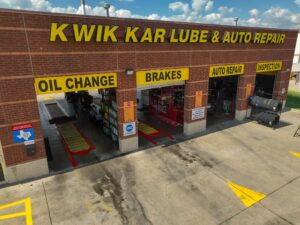Why Changing Air Filters Matters More Than You Think
Changing your air filter is a simple task, but it's often overlooked. This seemingly small maintenance item plays a surprisingly large role in your overall health, the efficiency of your home's systems, and your finances. Ignoring your air filter is similar to neglecting oil changes in your car – eventually, problems will arise.
The Hidden Costs of a Clogged Filter
A dirty air filter restricts airflow, making your HVAC system work harder. This added strain leads to higher energy bills. Imagine breathing through a straw; it requires more effort and energy. A clogged filter also struggles to trap dust, pollen, and other allergens. This results in poorer indoor air quality, which can worsen allergies and respiratory problems.
Beyond the Obvious: Long-Term Impacts
Beyond the immediate effects, neglecting air filter changes can shorten the lifespan of your HVAC system. The increased burden on the motor and other components causes premature wear and tear, potentially leading to expensive repairs in the future. Regular filter changes aren't just about clean air; they're an investment in the long-term health of your HVAC system. Much like regular oil changes for a car, air filter replacements are crucial for your home.
Air filter replacement frequency also impacts various systems in commercial and industrial settings. In controlled environments like data centers, changing filters 3-4 times annually is standard. In more demanding environments, such as medical facilities, filters might be changed every few months to maintain optimal performance. This regular maintenance is essential to prevent airflow reduction and potential equipment failure. Learn more about proper air filter maintenance here: https://www.uaf.com/news/time-replace-air-filters/
From Neglect to Proactive Maintenance
Regularly changing your air filter is a small price to pay for the many benefits it offers. It's a proactive step that protects your health, your HVAC system, and your budget. By understanding the importance of air filter changes and making it a routine, you can avoid hidden costs and ensure a healthier, more efficient home.
Home HVAC Filters: Finding Your Perfect Replacement Schedule
Your home's environment plays a significant role in determining how often you should change your HVAC air filter. Factors like pets, the number of people living in your home, and even the air quality in your neighborhood all contribute to how quickly your filter gets dirty. Generic advice often falls short; a personalized schedule is the best way to optimize both your indoor air quality and the efficiency of your HVAC system.
Factors Influencing Filter Replacement
Several factors influence the ideal air filter replacement schedule. If you have pets, you’ll likely find your filters accumulate dander much faster than homes without pets, requiring more frequent changes. Homes with allergy sufferers also benefit from frequent filter changes, especially during periods of high pollen. Your geographic location is another factor. Living in a dusty or high-pollution area necessitates more frequent filter replacements compared to a home in a cleaner environment.
The type of filter you use makes a difference, too. Fiberglass filters, while inexpensive, typically need replacing every month. Pleated filters offer improved filtration and a longer lifespan, usually around three months. High-efficiency HEPA filters offer the best protection against airborne particles and can last six to twelve months. The infographic below illustrates the typical replacement intervals for these three common filter types.
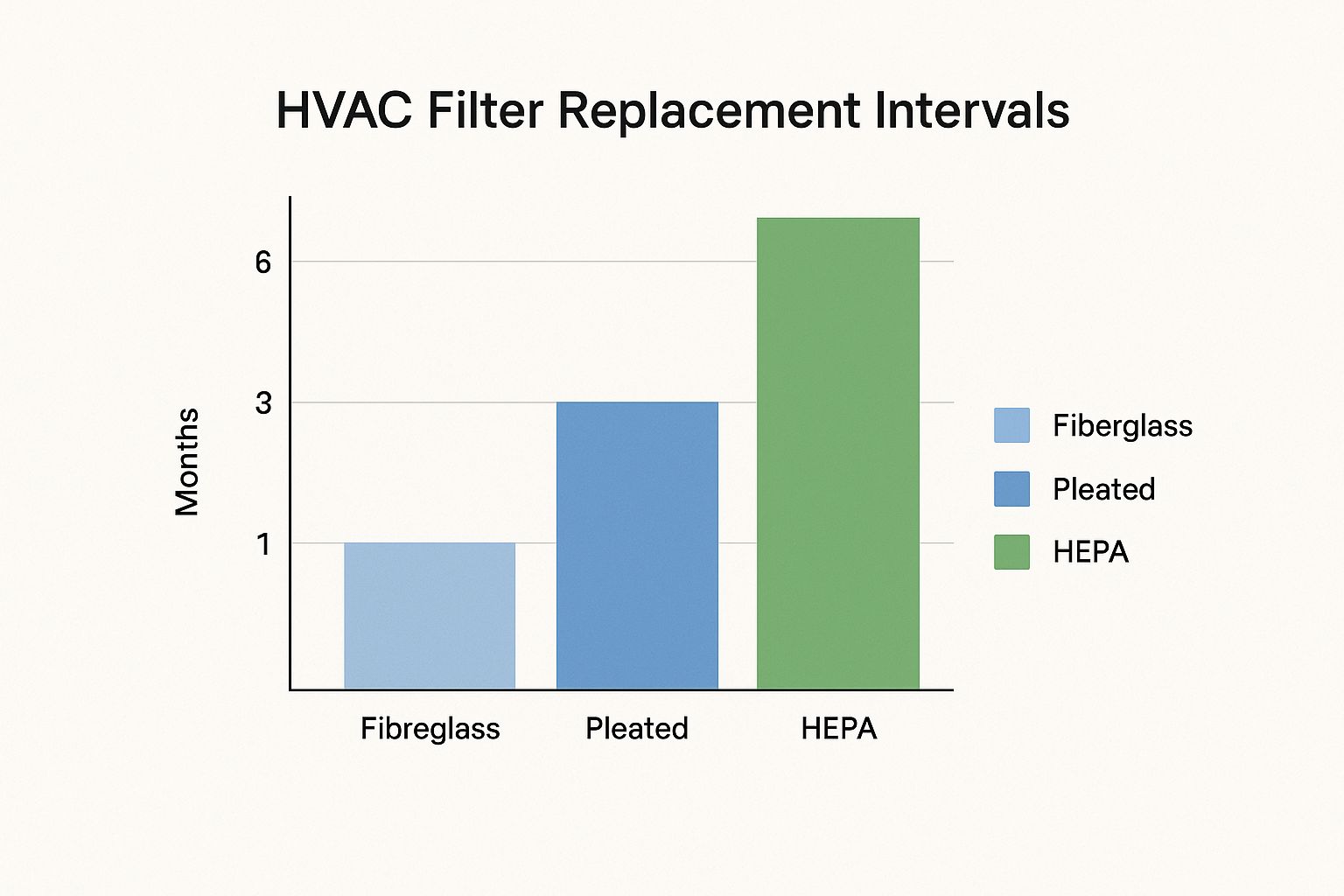
As the infographic demonstrates, HEPA filters offer the longest service life, followed by pleated filters, and then fiberglass filters. This highlights the importance of choosing the right filter type to meet your specific needs and budget. While HEPA filters last the longest, they also come with a higher price tag. Balancing cost, performance, and desired air quality is key when selecting an air filter.
To help you choose the right filter and replacement schedule for your specific needs, consider the information provided in the table below:
HVAC Filter Replacement Schedule by Type and Household Factors
This table provides recommended replacement frequencies for different types of HVAC filters based on household characteristics.
| Filter Type | Basic Recommendation | With Pets | With Allergies | During High Pollen Season |
|---|---|---|---|---|
| Fiberglass | 1 month | 2-3 weeks | 2-3 weeks | 2 weeks |
| Pleated | 3 months | 1-2 months | 1-2 months | 4-6 weeks |
| HEPA | 6-12 months | 4-6 months | 4-6 months | 3-4 months |
This table shows that while general guidelines exist, you might need to replace your filter more frequently depending on your household situation and the time of year.
Recognizing the Need for a Change
Beyond sticking to a schedule, knowing how to recognize the signs of a dirty air filter is important. Reduced airflow from your vents is a telltale sign. If your HVAC system runs longer than usual or struggles to maintain the desired temperature, a clogged filter may be the problem. Increased dust buildup on furniture and surfaces can also indicate a filter that needs replacing. These subtle signs can help you determine if a filter change is needed sooner than your planned schedule.
Establishing a Personalized System
Creating a personalized filter replacement schedule involves considering all of these factors. Start with the manufacturer's recommendations for your specific filter type. Then, adjust that timeframe based on your household's unique characteristics and environment. This personalized approach will not only maintain optimal air quality, but it will also help extend the life of your HVAC system, ultimately saving you money over time. It's a small change that makes a big difference for your health, comfort, and budget.
Vehicle Air Filters: Protecting Your Car and Passengers
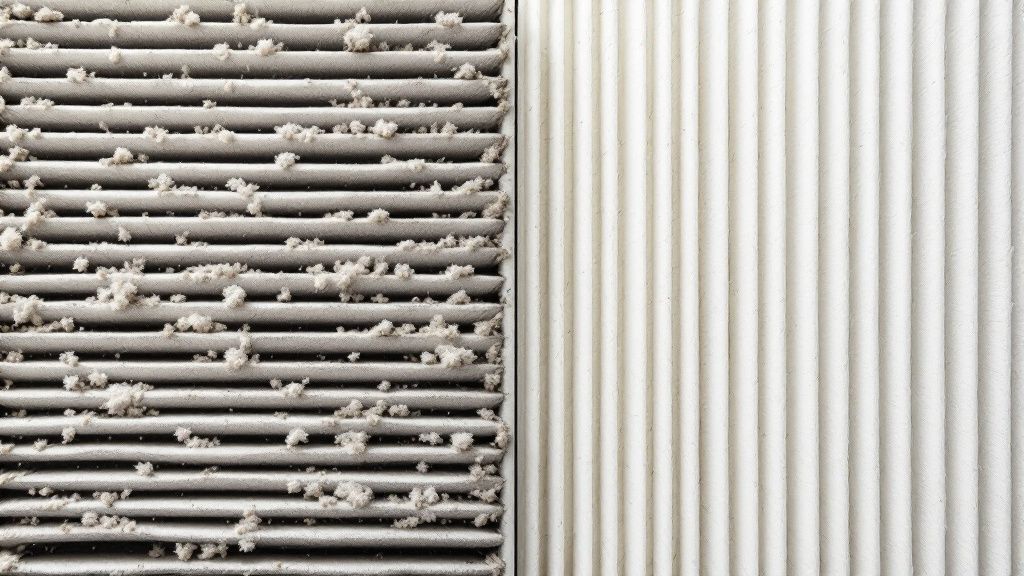
Just like your home, your car needs clean air to function correctly. Your vehicle depends on two types of air filters: the engine air filter and the cabin air filter. These components serve different purposes and require separate maintenance schedules. Understanding their roles and how often to replace them is vital for both your car's performance and your passengers' well-being.
Engine Air Filter: The Unsung Hero of Performance
The engine air filter is designed to keep dust, debris, and insects out of your engine. This ensures the proper mixture of air and fuel, optimizing combustion and fuel efficiency. Neglecting your engine air filter can result in reduced gas mileage and sluggish acceleration. Over time, a clogged filter can even lead to engine damage.
Think of it like trying to breathe with a stuffy nose. Restricted airflow makes it harder to function efficiently.
Cabin Air Filter: Breathe Easy Inside
Often overlooked, the cabin air filter cleans the air circulating inside your vehicle. This provides cleaner, healthier air for you and your passengers by filtering out pollen, dust, and other airborne pollutants. Regularly replacing this filter helps maintain a comfortable and healthy environment within your car, especially beneficial for those with allergies.
How Often Change Air Filter in Your Car?
Several factors influence how frequently you should change your car's air filters, including driving conditions and filter type. Driving in heavy traffic or on dusty roads will clog filters faster than highway driving. Generally, manufacturers recommend changing the engine air filter every 12,000 to 15,000 miles. Cabin air filters usually need replacing every 15,000 to 25,000 miles, or at least annually. Always consult your owner's manual for specific guidelines.
Interestingly, the global demand for air filters is on the rise. Driven by growing concerns about air quality, the market was valued at $17.3 billion in 2024. Projections suggest it will reach $26.2 billion by 2030. Stringent emissions standards, requiring high-performance filters, are partly fueling this growth. Find more detailed statistics here: Global Air Filters Market Overview 2024-2030.
Checking Your Filters: A Simple Visual Inspection
A quick visual check can easily determine the condition of your air filters. A dirty engine air filter will appear dark and clogged. A dirty cabin air filter might look gray or black, possibly with trapped leaves or insects. If your filters look dirty, it’s time for a change. This proactive approach helps prevent costly repairs and keeps your car running smoothly.
Specialty Filters: When Standard Replacement Rules Don't Apply
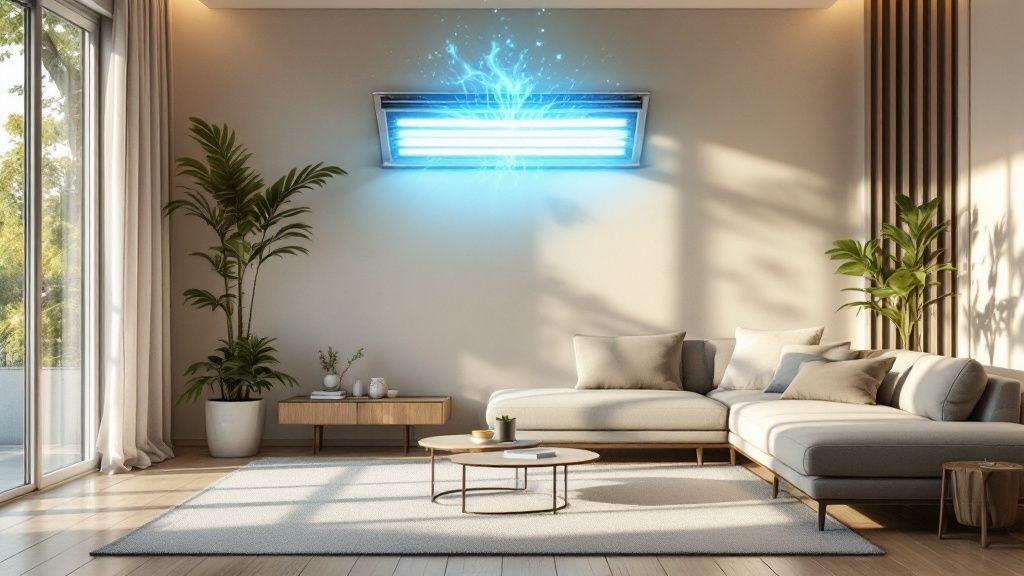
Specialty filters, like HEPA filters, are designed for superior air purification. Their maintenance, however, differs significantly from standard filters. While general guidelines can be useful, understanding the unique needs of these high-performance filters is key. Proper maintenance maximizes their effectiveness and lifespan, saving you money and contributing to a healthier home.
HEPA Filters: Balancing Performance and Lifespan
HEPA filters, known for trapping incredibly small particles, often come with a higher price tag. Their lifespan isn't always as predictable as standard filters. Just like following a car maintenance schedule helps ensure the longevity of your vehicle, understanding what impacts a HEPA filter's life is crucial.
Several factors influence how long a HEPA filter lasts, including usage and the surrounding environment. Some sources recommend replacing them every 3 years, while others suggest up to 8 years is possible. This variance underscores the need for regular checks to determine the right replacement time. HEPA filters capture small particles like dust, pollen, and bacteria, which are vital for good indoor air quality. Learn more about HEPA filter replacement frequency here. Simply following generic replacement schedules can lead to prematurely discarding a functional filter or reduced air quality from an overworked one.
Factors Impacting Specialty Filter Life
Beyond typical use, several other factors influence how often you should change specialty filters. High humidity, for instance, can encourage mold growth, requiring more frequent changes. Environments with high levels of particulate matter will also clog filters faster. This is especially true for air purifiers running constantly in heavily polluted areas.
Imagine a sponge: one used in a muddy puddle fills up much quicker than one wiping a small spill. Similarly, a HEPA filter in a smoky environment needs changing more often than one in a clean home. Understanding your environment is essential for a good maintenance schedule.
Practical Inspection and Maintenance Tips
Rather than relying solely on set timelines, regular inspections are a great way to assess filter condition. Check for visible discoloration or increased airflow resistance; these signs indicate the filter is nearing its end. Don't mistake a light dusting for a truly clogged filter, though. Some air purifiers even have sensors that alert you when replacement is needed.
This proactive approach balances optimal air quality with the cost of these special filters. For example, gently tapping a HEPA filter can dislodge loose dust, extending its life and preventing early replacement. These practical tips help balance cost with air purification needs.
Environmental Factors That Transform Your Filter Timeline
Where you live plays a big role in how often you need to change your air filters. General guidelines are helpful, but understanding the specifics of your environment lets you create a better maintenance plan. This keeps your air clean and protects your HVAC system. Just like your car needs more frequent oil changes under stress, your home's filters react to environmental challenges.
The Impact of Urban Pollution
City living often means more air pollution. Exhaust, industrial emissions, and construction dust clog filters faster, reducing their efficiency and affecting your indoor air quality. If you're near a busy road or in a city center, knowing how often to change air filters is key. Ignoring this can lead to HVAC problems and higher energy bills.
Pollen and Seasonal Allergies
Pollen can significantly shorten a filter's lifespan. During allergy season, filters quickly become saturated with pollen, making them less effective at trapping allergens. This can make allergies worse. Changing filters before and during allergy season can dramatically improve your indoor air quality.
Your Home's Construction and Surroundings
Your home's construction and surroundings also matter. Older insulation or living near a construction site can mean more dust and debris, requiring more frequent filter changes. Living near trees or fields also means more pollen and airborne particles, meaning more filter changes. Understanding these factors helps you plan better. If standard rules don't work for you, consider eco-friendly filter options.
Adapting Your Filter Maintenance Strategy
Adapting your filter maintenance to your environment is essential. Checking local air quality reports and pollen counts helps you know when to change filters more often. You can also check your filter visually. If it's discolored or dusty, change it, even if it's not time yet. This keeps your air clean and protects your HVAC system.
To help you visualize the impact of environmental factors, take a look at the table below:
Environmental Factors Impact on Filter Replacement Frequency
This table shows how different environmental conditions affect how often you should change your air filters across various systems.
| Environmental Factor | Impact Level | HVAC Filter Effect | Vehicle Filter Effect | Air Purifier Filter Effect |
|---|---|---|---|---|
| High Urban Pollution | High | Change every 1-2 months | Change every 10,000-15,000 miles | Change every 2-3 months |
| High Pollen Count | Moderate | Change every 2-3 months | Less significant | Change every 1-2 months |
| Construction Site Proximity | High | Change every 1-2 months | Less significant | Change every 2-3 months |
| Rural Environment with Trees/Fields | Moderate | Change every 2-3 months | Less significant | Change every 2-3 months |
| Low Pollution, Low Pollen | Low | Change every 3-6 months | Change every 20,000-30,000 miles | Change every 4-6 months |
As shown in the table, factors like high urban pollution and proximity to construction sites significantly increase the need for frequent filter changes across various systems. In contrast, areas with lower pollution and pollen allow for longer filter lifespans. Understanding these differences allows you to optimize your filter replacement schedule and maintain healthy air quality.
Building Your Personalized Filter Maintenance System
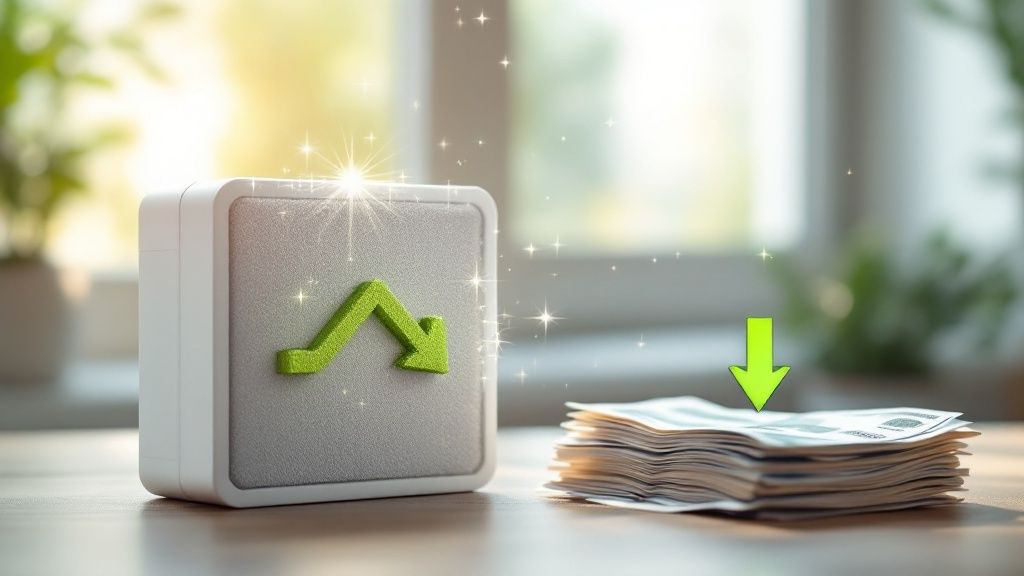
Now that we've discussed different air filter types and general guidelines, let's focus on creating a personalized maintenance system. This goes beyond standard advice to create a system that truly fits your lifestyle and environment. This personalized approach not only improves your home's air quality but also saves you money and avoids those last-minute trips to the store.
Developing Habits That Stick
Consistency is the key to proper air filter maintenance. Just like building any new habit, finding a routine that works for you is essential. Consider linking filter changes to other regular household tasks. For example, changing your filters when you change your smoke detector batteries or pay quarterly bills can be a great way to stay on track.
Digital tools can also be helpful. Setting calendar reminders or using a home maintenance app can keep you organized without the constant buzzing of notifications.
Strategic Seasonal Adjustments
Effective maintenance goes beyond simply following a rigid schedule. Think about how the changing seasons affect your filter's workload. During periods with high pollen counts, you might need to change your filters more frequently than during the winter months.
If you live in a dusty area, increasing the filter change frequency during the summer can significantly improve your system's performance and overall air quality. This adaptable approach ensures clean air and protects your HVAC equipment without unnecessary filter replacements.
Cost-Effective Purchasing and Storage
Buying filters in bulk can often save you money. However, proper storage is vital to maintain their effectiveness. Always store your filters in a cool, dry location, away from direct sunlight and moisture.
A simple, organized storage system will protect your investment and simplify the replacement process.
Analyzing Replacement Strategies
Let's compare different filter replacement approaches, ranging from strictly following manufacturer recommendations to changing them based on their condition:
| Replacement Strategy | Pros | Cons |
|---|---|---|
| Strict Adherence to Manufacturer Recommendations | Easy to remember | May not be optimal for your specific environment |
| Condition-Based Changes | Directly addresses current conditions | Requires regular visual checks of the filter |
| Personalized, Seasonally Adjusted Schedule | Balances convenience and effectiveness | Requires initial planning and observation |
This comparison highlights the benefits of a personalized strategy. By tailoring your maintenance to your unique needs and observations, you optimize both filter performance and cost-effectiveness.
Refining Your System Over Time
No system is perfect right away. Regularly checking the condition of your replaced filters offers valuable feedback. A very dirty filter suggests you should change it more often, while a relatively clean filter might indicate you can extend the interval. This ongoing process of observation and adjustment helps you create a highly effective, personalized system.

